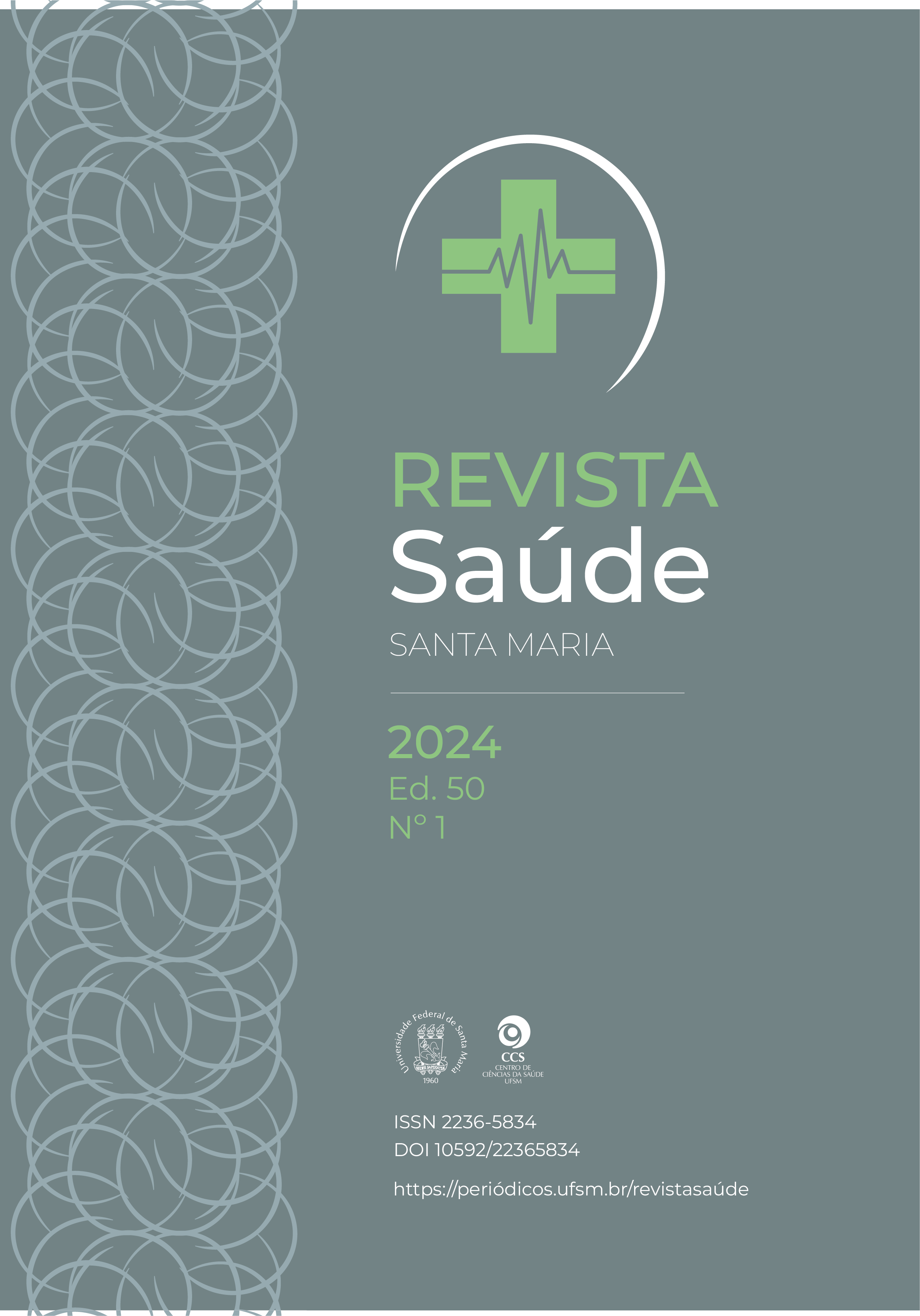Influence of a home exercise program through telemonitoring on gait speed and risk of falls in chronic hemiparetics
DOI:
https://doi.org/10.5902/2236583475229Keywords:
Stroke; walking speed; Telemonitoring.Abstract
Abstract: The aim of the study was to analyze the influence of a global home exercise program accompanied by telemonitoring on gait speed and the risk of falls in patients with post-stroke hemiparesis, as well as to verify possible between gait speed variables and gait the risk of falls. Methods: a cross-sectional survey was carried out with an and descriptive and inferential analysis. Data collection is based on the application of sociodemographic characterization tests, the 10-meter Walk Test (TC10), Dynamic Gait Index (DGI) and the Electronic Baropodometry Platform. Results: After the intervention, it was possible to observe an increase in the risk of falls and a decrease in gait speed, as well as, the evaluated variables showed a significant correlation with each other. Final considerations: The home exercise program accompanied by telemonitoring did not have a significant effect on gait speed, however, it showed a relationship with an increased risk of falls, and it should be noted that gait speed also showed an association with the risk of falls.
Downloads
References
REFERÊNCIAS
Lattouf NA, Tomb R, Assi A, et al. Eccentric training effects for patients with post-stroke hemiparesis on strength and speed gait: a randomized controlled trial. Neurorehabilitation, [S.L.], v. 48, n. 4, p. 513-522, 16 jun. 2021. DOI: 10.3233/nre-201601. DOI: https://doi.org/10.3233/NRE-201601
Chua K, Lim WS, Lim PH, et al. An Exploratory Clinical Study on na Automated, Speed-Sensing Treadmill Prototype With Partial Body Weight Support for Hemiparetic Gait Rehabilitation in Subacute and Chronic Stroke Patients. Front. Neurol. 11:747. DOI: 10.3389/fneur.2020.00747. DOI: https://doi.org/10.3389/fneur.2020.00747
Sául TLP, Enriconi J, Bonetti LV, Saccani, R. A influência de atividades de dupla tarefa na cinemática da marcha de indivíduos com hemiparesia espástica. Revista de Ciências Médicas e Biológicas, [S.L.], v. 20, n. 1, p. 40, 5 maio 2021. DOI: 10.9771/cmbio.v20i1.36888. DOI: https://doi.org/10.9771/cmbio.v20i1.36888
Tsushima Y, Fujita K, Miaki H, Kobayashi Y. Effects of increasing non-paretic step length on paretic leg movement during hemiparetic gait: a pilot study. Journal Of Physical Therapy Science, [S.L.], v. 34, n. 8, p. 590-595, 2022. DOI: 10.1589/jpts.34.590. DOI: https://doi.org/10.1589/jpts.34.590
Kim CH, Chu H, Kang GH, et al. Difference in gait recovery rate of hemiparetic stroke patients according to paralyzed side. Medicine, [S.L.], v. 98, n. 46, p. 18023, nov. 2019 DOI: 10.1097/md.0000000000018023. DOI: https://doi.org/10.1097/MD.0000000000018023
Huizenga D, Rashford L, Darcy B, et al. Wearable gait device for stroke gait rehabilitation at home. Topics In Stroke Rehabilitation, [S.L.], v. 28, n. 6, p. 443-455, 2 dez. 2020. DOI: 10.1080/10749357.2020.1834272. DOI: https://doi.org/10.1080/10749357.2020.1834272
Guidoti AB, Silveira CP, Rosa OS, et al. Fisioterapia na atenção básica em pacientes pós acidente vascular cerebral. Revista Neurociências, 29, 1–19. 2021. DOI: 10.34024/rnc.2021.v29.12249. DOI: https://doi.org/10.34024/rnc.2021.v29.12249
Tchero H, Teguo MT, Lannuzel A, Rusch E. Telerehabilitation for Stroke Survivors: Systematic Review and Meta-Analysis. J Med Internet Res. 2018;20(10):e10867. Doi: 10.2196/10867. DOI: https://doi.org/10.2196/10867
Salgueiro C, Urrotia G, Cabanas-Valdés R. Influence of Core-Stability Exercises Guided by a Telerehabilitation App on Trunk Performance, Balance and Gait Performance in Chronic Stroke Survivors: a preliminary randomized controlled trial. International Journal Of Environmental Research And Public Health, [S.L.], v. 19, n. 9, p. 5689, 7 maio 2022. DOI: 10.3390/ijerph19095689. DOI: https://doi.org/10.3390/ijerph19095689
Tasseel-Ponche S, Delafontaine A, Godefroy O, et al. Walking speed at the acute and subacute stroke stage: A descriptive meta-analysis. Front. Neurol. 13:989622. 2022. Doi: 10.3389/fneur.2022.989622. DOI: https://doi.org/10.3389/fneur.2022.989622
Lim JH, Lee HS, Song CS. Home-based rehabilitation programs on postural balance, walking, and quality of life in patients with stroke: a single-blind, randomized controlled trial. Medicine. 2021. DOI: 10.1097/MD.0000000000027154. DOI: https://doi.org/10.1097/MD.0000000000027154
Chang KW, Lin CM; Yen CW, et al. The Effect of Walking Backward on a Treadmill on Balance, Speed of Walking and Cardiopulmonary Fitness for Patients with Chronic Stroke: a pilot study. International Journal Of Environmental Research And Public Health, [S.L.], v. 18, n. 5, p. 2376, 1 mar. 2021. DOI: 10.3390/ijerph18052376. DOI: https://doi.org/10.3390/ijerph18052376
Liang JN, Ho KY, Lee YJ, et al. Slow Walking in Individuals with Chronic Post-Stroke Hemiparesis: speed mediated effects of gait kinetics and ankle kinematics. Brain Sciences, [S.L.], v. 11, n. 3, p. 365, 13 mar. 2021. DOI: 10.3390/brainsci11030365. DOI: https://doi.org/10.3390/brainsci11030365
Chumbler NR, Li X, Quigley P, et al. A randomized controlled trial on Stroke telerehabilitation: the effects on falls self-efficacy and satisfaction with care. Journal Of Telemedicine And Telecare, [S.L.], v. 21, n. 3, p. 139-143, 12 fev. 2015. DOI: 10.1177/1357633x15571995. DOI: https://doi.org/10.1177/1357633X15571995
Paula S, Laux KC, Sartori GC, Grieble KC. Correlação entre o risco para quedas e a independência funcional de pacientes hemiparéticos. Revista Pesquisa em Fisioterapia, [S.L.], v. 7, n. 4, p. 558-565, 22 nov. 2017. DOI: 10.17267/2238-2704rpf.v7i4.1652. DOI: https://doi.org/10.17267/2238-2704rpf.v7i4.1652
Laver K, Adey-Wakeling Z, Crotty M, et al. Telerehabilitation services for stroke. Cochrane Database Of Systematic Reviews, [S.L.], v. 2020, n. 1, p. 1-10, 31 jan. 2020. DOI: 10.1002/14651858.cd010255. DOI: https://doi.org/10.1002/14651858.CD010255.pub3
Downloads
Published
How to Cite
Issue
Section
License
Copyright (c) 2024 Lucas Mateus Campos Bueno, Débora Toshimi Furuta, Danilo Castriani Santos, Dyenifer Fernandes de Oliveira, Paula Yukari Otaguiri, Guilherme Yassuyuki Tacao, Isabella Cristina Leoci, Augusto Cesinando de Carvalho

This work is licensed under a Creative Commons Attribution-NonCommercial-NoDerivatives 4.0 International License.
A Declaração de Direito Autoral e os itens a serem observados podem ser visualizados no seguinte link: http://cascavel.ufsm.br/revistas/ojs-2.2.2/index.php/seculoxxi/information/sampleCopyrightWording





